Polaris® Kinematic Mirror Mounts with Vertical-Drive Adjusters
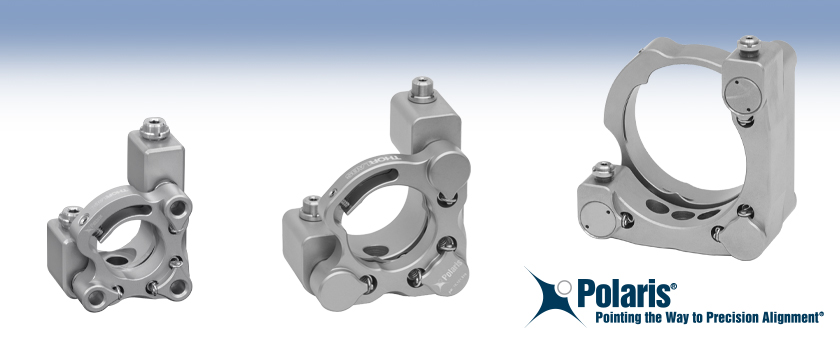
- Designed for Long-Term Stability
- Patented Monolithic Flexure Arm Design for Minimal Optic Distortion
- Right- and Left-Handed Versions Available
POLARIS-K1VS2
2-Adjuster Mirror Mount
for Ø1" Optics
with Vertical Drive
POLARIS-K2VS2L
2-Adjuster Mirror Mount
for Ø2" Optics
with Vertical Drive
US Patents 10,101,559 & 11,320,621
POLARIS-K05VS2
2-Adjuster Mirror Mount
for Ø1/2" Optics
with Vertical Drive

Please Wait

Click to Enlarge
Using the POLARIS-K1VS2 Ø1" Mount:
A: POLARIS-T2 Tool for Adjusting POLARIS-LNS1 Collars
B: 5/64" or 2.0 mm Hex Key in the End of an Adjuster
C: POLARIS-N5 Removable Knobs on the Adjusters*
D: HKTS-5/64 Hex Knobs on the Adjusters
Separate accessories are available for use with the
POLARIS-K05VS2 Ø1/2" Mount.

Click to Enlarge
POLARIS-K1VS2 Ø1" Mount Shown with Optional POLARIS-N5 Removable Knobs* (Not Included)
Features
- Machined from Heat-Treated Stainless Steel with Low Coefficient of Thermal Expansion (CTE)
- Hardened Stainless Steel Ball Contacts with Sapphire Seats for Durability and Smooth Movement
- Matched Actuator and Back Plate Provide Stability and Smooth Kinematic Adjustment
- Extensive Testing Guarantees no more than 2 μrad Deviation after 12.5 °C Temperature Cycling (See Test Data Tab for Details)
- Passivated Stainless Steel Surface Ideal for Vacuum and High-Power Laser Cavity Applications
- Patented Optic Bore Design with Monolithic Flexure Arm (US Patent 10,101,559)
- Patented Transverse Drive (US Patent 11,320,621) Provides Ultra Stable Kinematic Movement Via Hardened and Precision Finished Stainless Steel Components
- Custom Mount Configurations are Available by Contacting Tech Support
Polaris® Low-Drift Kinematic Mirror Mounts are the ultimate solution for applications requiring stringent long-term alignment stability. The vertical drives incorporated in the mounts below are ideal for setups where there may not be space behind the mount for horizontal access to the adjusters, such as the interior of a laser cavity.
Optic Retention
These mounts feature a patented optic bore design with a monolithic flexure arm. This design provides high holding force and pointing stability with minimal optic distortion. For more details, please see the Test Data tab.
Polaris optic bores are precision machined to achieve a fit that provides optimum beam pointing stability over changing environmental conditions, such as temperature changes, transportation shock, and vibration. These vertical-drive mounts are specifically designed for Ø1/2", Ø1", Ø1.5", or Ø2" optics. They can be customized with different faceplates, such as those used in our Ø25 mm or Ø50 mm mirror mounts, low-distortion optic retention mounts, or glue-in mounts. Please contact Tech Support with inquiries.
Design
Machined from heat-treated stainless steel, Polaris mounts utilize precision-matched adjusters with ball contacts and sapphire seats to provide smooth kinematic adjustment. As shown on the Test Data tab, these mounts have undergone extensive testing to ensure high-quality performance. The Polaris design addresses all of the common causes of beam misalignment; please refer to the Design Features tab for detailed information.
Post Mounting
These Polaris vertical-drive mirror mounts are equipped with #8 (M4) counterbores for post mounting. Ø2 mm alignment pin holes around the mounting counterbore allow for precision alignment when paired with our posts for Polaris mirror mounts.
Mounts can be custom-configured with the mounting and alignment pin holes on the adjacent side of the back plate, so that the adjusters are oriented horizontally. Please contact Tech Support with inquiries.
See the Usage Tips tab for more recommendations about mounting configurations.
Cleanroom and Vacuum Compatibility
All Polaris mounts, removable knobs, and locking collars sold on this page are designed to be compatible with cleanroom and vacuum applications. See the Specs tab and the Design Features tab for details.
*POLARIS-N5 Removable Knobs thread directly onto the exposed adjuster screws. Installing them on the Vertical Drive Mounts below may result in a reduced mechanical angular range.
| Item # Suffixa | -K05VS2 | -K05VS2L | -K1VS2 | -K1VS2L | -K15VS2 | -K15VS2L | -K2VS2 | -K2VS2L |
|---|---|---|---|---|---|---|---|---|
| Optic Sizeb | Ø1/2" | Ø1" | Ø1.5" | Ø2" | ||||
| Mount Configuration | Right-Handed | Left-Handed | Right-Handed | Left-Handed | Right-Handed | Left-Handed | Right-Handed | Left-Handed |
| Optic Thickness (Min) | 0.08" (2 mm) | 0.14" (3.5 mm) | 0.24" (6.0 mm) | 0.14" (3.5 mm) | ||||
| Number of Adjusters | Two | |||||||
| Adjuster Drive | Vertical Drive, 5/64" (2.0 mm) Hex | |||||||
| Adjuster Pitch | 130 TPI | 100 TPI | ||||||
| Actuator Matching | Matched Actuator/Body Pairs | |||||||
| Measured Point-to-Point Mechanical Resolution per Adjuster (Bidirectional Repeatability) |
5 µrad (Typical); 2 µrad (Achievable) |
|||||||
| Adjustment per Revolutionc | ~11 mrad/rev | ~7.7 mrad/rev | ~5.5 mrad/rev | ~5 mrad/rev | ||||
| Mechanical Angular Range (Nominal) | +3°/-2.5° | ±4° | ±3° | ±3° | ||||
| Front Plate Separation at Pivot Adjuster | 0.06" (1.5 mm) | 3.175 mm (0.125") | ||||||
| Beam Deviationd After Thermal Cycling | <2 µrad | <1 μrad | ≤1 μrad | ≤2 μrad | ||||
| Recommended Optic Mounting Torquee | 8 - 12 oz-in for 6 mm Thick UVFS Optics |
5 - 7 oz-in for 6 mm Thick UVFS Optics |
5 - 7 oz-in for 6 mm Thick UVFS Optics |
4 - 6 oz-in for 12 mm Thick UVFS Optics |
||||
| Mounting | One #8 (M4) Counterbore | Three #8 (M4) Counterbores | ||||||
| Alignment Pin Holes | Two on Either Side of Center Counterboref | |||||||
| Vacuum Compatibilityg | 10-9 Torr at 25 °C with Proper Bake Out 10-5 Torr at 25 °C without Bake Out Grease Vapor Pressure: 10-13 Torr at 20 °C; 10-5 Torr at 200 °C Epoxy Meets Low Outgassing Standards NASA ASTM E595, Telcordia GR-1221 |
|||||||
| Operating Temperature Range | -30 to 200 °C | |||||||
Polaris Mirror Mounts Test Data
All of the Polaris Low-Drift Kinematic Mirror Mounts have undergone extensive testing to ensure high-quality performance. Thermal Shock testing confirms the exceptional stability of the mounts and demonstrates that they reliably return to their initial position after a transient temperature shift. Interferometric wavefront distortion testing demonstrates the ability of Polaris mounts to secure an optic without significantly distorting the optical surface.
Vibration Testing for Polaris Mounts (Ø19 mm Polaris Mount Shown)
Vibration Testing
Purpose: This testing was done to determine how reliably Polaris mirror mounts behave when subjected to intense physical vibrations.
Procedure: A pair of identical mirror mounts were mounted on Ø1" Posts for Polaris Mirror Mounts and secured to a stainless steel breadboard with POLARIS-CA1 clamping arms. Laser beams were reflected from the mirrors onto two position sensing detectors, located on the same breadboard. The entire platform was vibrated with a variable frequency and amplitude and the displacement of the beam on the detector was recorded. The two beam paths were oriented at right angles so that the vibrational motion was in a direction parallel to the face of one mount and perpendicular to the face of the other. Please see the video to the right for a demonstration of our Polaris vibration test (the mount shown in the video is the POLARIS-K19S4).
Results: When subjected to vibrational frequencies as high as 100 Hz and accelerations as high as 6 g, the mounts remained mechanically sound. The angular position of the mounts remained stable within about 10 µrad for both parallel and perpendicular vibrations.
Conclusions: Our Polaris mirror mounts provide exceptional performance, even under rugged operating conditions. As a result, these mounts are ideal for use in systems that require the greatest degree of stability when vibrational noise is expected. Vertical-drive Polaris mounts share all of the relevant design aspects of the tested mount.
Positional Repeatability After Thermal Shock
Purpose: This testing was done to determine how reliably the mount returns the mirror, without hysteresis, to its initial position. These measurements show that the alignment of the optical system is unaffected by the temperature shock.
Procedure: After mounting the Polaris to a Ø1" Post, the mirror and post assembly was secured to a stainless steel optical table in a temperature-controlled environment. The mirror was held using the flexure mechanism; see the Usage Tips tab for additional mounting recommendations. A beam from an independently temperature-stabilized laser diode was reflected by the mirror onto a position sensing detector. The temperature of each mirror mount tested was raised to at least 37 °C. The elevated temperature was maintained in order to soak the mount at a constant temperature. Then the temperature of the mirror mount was returned to the starting temperature. The results of these tests are shown below.
Results: As can be seen in the plots below, when the Polaris mounts were returned to their initial temperature, the angular position (both pitch and yaw) of the mirrors returned to within 1 µrad of its initial position for our Ø1/2" and Ø1" mounts and within 2 µrad for our Ø2" mounts. The best result achieved with a competitor’s mount was significantly worse than the Polaris mounts. The performance of the Polaris was tested further by subjecting the mount to repeated temperature change cycles. After each cycle, the mirror’s position reliably returned to within 1 µrad of its initial position for the POLARIS-K1VS2(L) Ø1" mount and within 2 µrad for the POLARIS-K05VS2(L) Ø1/2" and POLARIS-K2VS2(L) Ø2" mounts.
Conclusions: The Polaris Mirror Mounts are high-quality, ultra-stable mounts that will reliably return a mirror to its original position after cycling through a temperature change. As a result, the Polaris mounts are ideal for use in applications that require long-term alignment stability.
| Ø1/2" 2-Adjuster Mounts, Monolithic Optic Retention, Vertical Drive |
|---|
 Click to Enlarge Thermal Repeatability for Ø1/2", 2-Adjuster POLARIS-K05VS2 Mirror Mount The POLARIS-K05VS2L behaves in a similar manner. |
|
The plots above show the final angular position of two different POLARIS-K05VS2 mounts for 35 consecutive thermal shock tests. Mount #1 had a 2" beam height and mount #2 had a 3" beam height. The change in temperature is the difference between the starting temperature and the temperature at the end of the test and includes factors such as the variation in room and mount temperature. The POLARIS-K05VS2L mount behaves in a similar manner.
|
| Ø1" 2-Adjuster Mounts, Monolithic Optic Retention, Vertical Drive |
|---|
 Click to Enlarge Thermal Repeatability for Ø1", 2-Adjuster POLARIS-K1VS2 Mirror Mount. The POLARIS-K1VS2L behaves in a similar manner. |
 Click to Enlarge The plot above shows the final angular position of the POLARIS-K1VS2 for 10 consecutive thermal shock tests. The change in temperature is the difference between the starting temperature and the temperature at the end of the test and includes factors such as the variation in room and mount temperature. The POLARIS-K1VS2L behaves in a similar manner. |
| Ø2" 2-Adjuster Mounts, Monolithic Optic Retention, Vertical Drive |
|---|
 Click to Enlarge Thermal Repeatability for Ø2", 2-Adjuster POLARIS-K2VS2 Mirror Mount. The POLARIS-K2VS2L behaves in a similar manner. |
 Click to Enlarge The plot above shows the final angular position of the POLARIS-K2VS2 for 20 consecutive thermal shock tests. The change in temperature is the difference between the starting temperature and the temperature at the end of the test and includes factors such as the variation in room and mount temperature. The POLARIS-K2VS2L behaves in a similar manner. |
Optical Distortion Testing Using a ZYGO Phase-Shifting Interferometer
Mounting stresses are responsible for the strain that results in optical surface distortion. Minimizing distortion effects is crucial; any distortion to the optic affects the reflected wavefront. Many of our Polaris mounts, including the vertical-drive mounts below, feature a monolithic flexure arm that is designed to provide maximum stability while minimizing optic distortion.
To determine the amount of optic distortion exerted on the mirror by the flexure arm, a ZYGO Phase-Shifting Interferometer was used to measure the wavefront distortion at different torque values (see the images below). Based on results of the tests seen below, we recommend a torque of 8 - 12 oz-in for our Ø1/2" Polaris mounts, 5 - 7 oz-in for our Ø1" and Ø1.5" Polaris mounts, and 4 - 6 oz-in for our Ø2" Polaris mounts.
Please note that the optimal optic mounting torque can vary by ±2 oz-in due to variations in optic thickness, diameter, and tolerance buildup.
Procedure:
A broadband dielectric mirror was installed into a Polaris mount using the setscrew to clamp down the flexure arm. Measurements of the optic distortion were then recorded using the ZYGO interferometer. Once each measurement was complete, the amount of force needed to push the optic out of the mount was measured to check optic retention. The wavefront distortion values shown here give peak-to-valley distortion across the entire optic, representing the worst-case scenario; the center of the optic exhibits significantly less distortion than the edge.
| POLARIS-K05VS2 Optical Distortion Test Data | ||
|---|---|---|
| Torque (oz-in)a |
Wavefront Distortion (Peak to Valley)b (Click for Example Zygo Screenshot) |
Push-Out Force (lbf)c |
| 7 | 0.04λ to 0.055λ | >12 |
| 7.5 | 0.037λ | |
| 8 | 0.037λ to 0.045λ | |
| 8.5 | 0.042λ | |
| 9 | 0.042λ to 0.051λ | |
| 9.5 | 0.045λ | |
| 10 | 0.049λ to 0.052λ | |
| 10.5 | 0.055λ | |
| 11 | 0.04λ to 0.052λ | |
| 11.5 | 0.063λ | |
| 12 | 0.064λ to 0.079λ | |
| 12.5 | 0.079λ | |
| 13 | 0.042λ to 0.049λ | |
| 13.5 | 0.061λ | |
| 14 | 0.047λ to 0.069λ | |
| 14.5 | 0.07λ | |
| 15 | 0.079λ to 0.083λ | |
| 15.5 | 0.075λ | |
| 16 | 0.065λ to 0.078λ | |
Results for Ø1/2" Polaris Vertical-Drive Mount:
This test was performed using the POLARIS-K05VS2 Ø1/2" Polaris Mount. The POLARIS-K05VS2L mount uses the same front plate and will show similar performance. As seen in the table to the right, the peak-to-valley wavefront distortion was found to be ≤0.1λ when 8 - 12 oz-in of torque was applied to the setscrew of the mount.
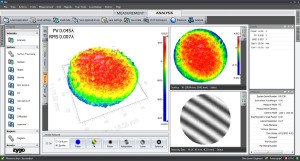
Click to Enlarge
POLARIS-K05VS2 Mount Wavefront Distortion for Optic Mounting Torque of 8 oz-in
(See Table to the Right for Other Setscrew Torques)
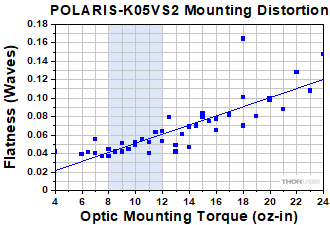
Click to Enlarge
POLARIS-K05VS2 Mount Wavefront Distortion for Various Optic Mounting Torque Values
Results for Ø1" Mount with Monolithic Optic Retention Arm:
This test was performed using the POLARIS-K1S4 Ø1" Polaris Mount, which uses a front plate with the same optic retention mechanism as the POLARIS-K1VS2 and POLARIS-K1VS2L Ø1" Vertical-Drive Mounts. As seen in the table below, the peak-to-valley wavefront distortion was found to be ≤0.1λ when 5 - 7 oz-in of torque was applied to the setscrew of the POLARIS-K1S4 Ø1" mount.
| POLARIS-K1S4 Optical Distortion Test Data | ||
|---|---|---|
| Torque (oz-in)a | Wavefront Distortion (Peak to Valley)b (Click for Example Zygo Screenshot) |
Push-Out Force (lbf)c |
| 4.5 | 0.072λ to 0.093λ | >12 |
| 5 | 0.047λ to 0.090λ | |
| 5.5 | 0.057λ to 0.097λ | |
| 6 | 0.085λ to 0.100λ | |
| 6.5 | 0.057λ to 0.073λ | |
| 7 | 0.059λ to 0.067λ | |
| 7.5 | 0.083λ to 0.092λ | |
| 8 | 0.128λ to 0.145λ | |
| 8.5 | 0.102λ to 0.117λ | |
| 9 | 0.141λ to 0.162λ | |
| 10 | 0.188λ to 0.224λ | |
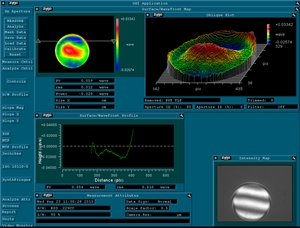
Click to Enlarge
POLARIS-K1S4 Wavefront Distortion for Setscrew Torque of 7 oz-in (See Table to the Right for Other Setscrew Torques)
Results for Ø1.5" Mount with Monolithic Optic Retention Arm:
This test was performed using the POLARIS-K15S4 Ø1.5" Polaris Mount, which uses a front plate with the same optic retention mechanism as the POLARIS-K15VS2 and POLARIS-K15VS2L Ø1.5" Vertical-Drive Mounts. As seen in the table below, the peak-to-valley wavefront distortion was found to be ≤0.173λ when 5 - 7 oz-in of torque was applied to the setscrew of the POLARIS-K15S4 Ø1.5" mount.
| POLARIS-K15S4 Optical Distortion Test Data | ||
|---|---|---|
| Torque (oz-in)a | Wavefront Distortion (Peak to Valley)b (Click for Example Zygo Screenshot) |
Push-Out Force (lbf)c |
| Unmounted | 0.083λ | >12 |
| 4 | 0.108λ | |
| 5 | 0.165λ | |
| 6 | 0.137λ | |
| 7 | 0.173λ | |
| 8 | 0.175λ | |
| 9 | 0.281λ | |
| 10 | 0.302λ | |

Click to Enlarge
POLARIS-K15S4 Wavefront Distortion for Setscrew Torque of 7 oz-in (See Table to the Right for Other Setscrew Torques)
Results for Ø2" Mount with Monolithic Optic Retention Arm:
This test was performed using the POLARIS-K2 Ø2" Polaris Mount, which uses a front plate with the same optic retention mechanism as the POLARIS-K2VS2 and POLARIS-K2VS2L Ø2" Vertical-Drive Mounts. As seen in the table below, the peak-to-valley wavefront distortion was found to be ≤0.1λ when 4 - 6 oz-in of torque was applied to the setscrew of the POLARIS-K2 Ø2" mount.
| POLARIS-K2 Optical Distortion Test Data | ||
|---|---|---|
| Torque (oz-in)a | Wavefront Distortion (Peak to Valley)b (Click for Example Zygo Screenshot) |
Push-Out Force (lbf)c |
| 4 | 0.075λ to 0.090λ | >12 |
| 5 | 0.076λ to 0.091λ | |
| 6 | 0.089λ to 0.100λ | |
| 7 | 0.115λ to 0.121λ | |
| 8 | 0.128λ to 0.139λ | |
| 9 | 0.172λ to 0.180λ | |
| 10 | 0.171λ to 0.182λ | |
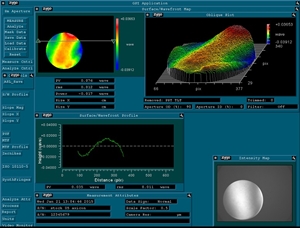
Click to Enlarge
POLARIS-K2 Wavefront Distortion for Setscrew Torque of 5 oz-in (See Table to the Right for Other Setscrew Torques)

Click to Enlarge
Design Features of the Polaris Vertical-Drive Mounts
Several common factors typically lead to beam misalignment in an optical setup. These include temperature-induced hysteresis of the mirror's position, crosstalk, drift, and backlash. Polaris mirror mounts are designed specifically to minimize these misalignment factors and thus provide extremely stable performance. Hours of extensive research, multiple design efforts using sophisticated design tools, and months of rigorous testing went into choosing the best components to provide an ideal solution for experiments requiring ultra-stable performance from a kinematic mirror mount.
Thermal Hysteresis
The temperature in most labs is not constant due to factors such as air conditioning, the number of people in the room, and the operating states of equipment. Thus, it is necessary that all mounts used in an alignment-sensitive optical setup be designed to minimize any thermally induced alignment effects. Thermal effects can be minimized by choosing materials with a low coefficient of thermal expansion (CTE), like stainless steel. However, even mounts made from a material with a low CTE do not typically return the mirror to its initial position when the initial temperature is restored. All the critical components of the Polaris mirror mounts are heat treated prior to assembly since this process removes internal stresses that can cause a temperature-dependent hysteresis. As a result, the alignment of the optical system will be restored when the temperature of the mirror mount is returned to the initial temperature.
The method by which the mirror is secured in the mount is another important design factor; these Polaris mounts offer excellent performance without the use of adhesives or setscrews. Setscrews, while commonly used by themselves for securing optics in other mounts, tend to move as the temperature changes. These Polaris mounts use a monolithic flexure arm to hold the edge of the optic, further reducing both sensitivity to fluctuations in temperature and distortion on the optic surface.
Crosstalk
Crosstalk is minimized by carefully controlling the dimensional tolerances of the front and back plates of the mount so that the pitch and yaw actuators are orthogonal. In addition, sapphire seats are used at all three contact points. Standard metal-to-metal actuator contact points will wear down over time. The polished sapphire seats of the Polaris mounts, in conjunction with the hardened stainless steel actuator tips, maintain the integrity of the contact surfaces over time.
Drift and Backlash
In order to minimize the positional drift of the mirror mount and backlash, it is necessary to limit the amount of play in the adjuster as well as the amount of lubricant used. When an adjustment is made to the actuator, the lubricant will be squeezed out of some spaces and built up in others. This non-equilibrium distribution of lubricant will slowly relax back into an equilibrium state. However, in doing so, this may cause the position of the front plate of the mount to move. The Polaris mounts use adjusters matched to the body or bushings that exceed all industry standards so very little adjuster lubricant is needed. As a result, alignment of the Polaris mounts is extremely stable even after being adjusted (see the Test Data tab for more information). In addition, these adjusters have a smooth feel that allows the user to make small, repeatable adjustments.

Click to Enlarge
All Vacuum Compatible Polaris Mounts are Shipped Inside Two Vacuum Bag Layers
Cleanroom and Vacuum Compatibility
All Polaris mounts, removable knobs, and lock nuts sold on this page are designed to be compatible with cleanroom and vacuum applications. They are chemically cleaned using the Carpenter AAA passivation method to remove sulfur, iron, and contaminants from the surface. After passivation, they are assembled in a clean environment and then double vacuum bagged to eliminate contamination when transported into a cleanroom.
The sapphire contacts are bonded into place using a NASA-approved low outgassing procedure. In addition, DuPont LVP High-Vacuum (Krytox) Grease, an ultra-high vacuum compatible, low outgassing PTFE grease, is applied to the adjusters. These features provide high vacuum compatibility and low outgassing performance. When operating at pressures below 10-5 Torr, we highly recommend using an appropriate bake out procedure prior to installing the mount in order to minimize contamination caused by outgassing. Please note that the 8-32 and M4 cap screws included with the Polaris mounts are not rated for pressures below 10-5 Torr.
Cleanroom-Compatible Packaging
Each vacuum-compatible Polaris mount is packaged within two vacuum bag layers after assembly in a clean environment, as seen in the image to the right. The vacuum-tight fit of the bags stabilizes the mount, limiting translation of the front plate due to shocks during transportation. The tight fit also minimizes rubbing against the bag, preventing the introduction of bag material shavings that would contaminate the clean mount.
In the vacuum-sealing process, moisture-containing air is drawn out of the packaging. This eliminates unwanted reactions on the surface of the mount without the need for desiccant materials. The vacuum bags protect the mount from contamination by air or dust during transport and storage, and the double-vacuum bag configuration allows for a straightforward and effective cleanroom entry procedure. The outer bag can be removed outside of the cleanroom, allowing the contaminant-free inner bag to be placed into a clean container and transferred into the cleanroom while retaining the benefits of vacuum-bag packaging. Inside the cleanroom, the mount can be removed from the inner bag when ready for use.
Through thermal changes and vibrations, the Polaris® kinematic mirror mounts are designed to provide years of use. Below are some usage tips to ensure the Polaris Vertical-Drive Mounts provide optimal performance.
Match Materials
Due to its relatively low coefficient of thermal expansion, stainless steel was chosen as the material from which to fabricate the front and back plates of these Polaris mounts. When mounting, we recommend using components fabricated from the same material, such as our Ø1" Posts for Polaris Mirror Mounts and Non-Bridging Clamping Arms.
Use a Wide Post
To optimize the performance of these Polaris mounts, they should be used with our Ø1" Posts and our Non-Bridging Clamping Arms. These posts are made of stainless steel and provide two lines of contact with the mount, which help confine the bottom of the mount during variations in the surrounding temperature, thereby minimizing potential alignment issues.

Click to Enlarge
The shaded 8 - 12 oz-in region in this plot denotes the recommended optic mounting torque for a 6 mm thick optic in the POLARIS-K05VS2 Ø1/2" mount. Over torquing the monolithic flexure arm past the recommended range can result in a significant increase in the surface distortion of mounted optics.
Optic Mounting
Since an optic is prone to movement within its mounting bore, all optics should be mounted with the Polaris out of the setup to ensure accurate mounting that will minimize misalignment effects. We recommend using a torque wrench when installing an optic in the Polaris mounts. Over torquing the monolithic flexure arm optic retainer past the recommended range can result in a significant increase in the surface distortion of mounted optics (see the graph to the right for an example).
Front Plate’s Position
To achieve the best mount performance, it is recommended that the front plate be kept as parallel as possible to the back plate. This ensures the highest stability of the adjustments.
Mount as Close to the Table’s Surface as Possible
To minimize the impact of vibrations and temperature changes, it is recommended that your setup has as low of a profile as possible. Using short posts will reduce the Y-axis translation caused by temperature variations and will minimize any movements caused by vibrations. Mount the Polaris directly onto a flat surface such as a breadboard using a 1/4"-20 to 8-32 thread adapter (AE8E25E) or M6 x 1.0 to M4 x 0.7 adapter (AE4M6M). By doing so, the instability introduced by a post will be eliminated.
Polish and Clean the Points of Contact
We highly recommend that the points of contact between the mount and the post, as well as the post and the table, are clean and free of scratches or defects. For best results, we recommend using a polishing stone to clean the table’s surface and a LF1P polishing pad for the top and bottom of the post as well as the bottom of the mount.
Use Polaris-Specific Adjustment Tools
For securing POLARIS-LNS05 locking collars (such as on Ø1/2" vertical-drive mount adjusters), we recommend using the POLARIS-T3 spanner wrench; the TW13 torque wrench can be used in combination with the spanner wrench for long-term locking. For securing POLARIS-LNS1 locking collars (such as on vertical-drive adjusters), we recommend using the POLARIS-T2 spanner wrench; the TW13 torque wrench can be used in combination with the spanner wrench for long-term locking. These wrenches are chemically cleaned and compatible with cleanroom and vacuum chamber applications.
We also offer POLARIS-N5 stainless steel knobs, which are compatible with mounts featuring actuators with 1/4"-100 threading; however, the addition of the knobs may reduce the angular adjustment range of the vertical drive mount.
Not Recommended
We do not recommend taking the adjusters out of the back plate, as it can contaminate the threading. This can reduce the fine adjustment performance significantly. Additionally, do not over-loosen the adjusters. Once the back plate stops moving, do not continue to turn the adjuster in the same direction; doing so may permanently damage the mount. Also, do not pull the front plate away as it might stretch the springs beyond their operating range or crack the sapphire seats. If you experience any issues related to the afforementioned warnings, please contact Tech Support for assistance.
| Posted Comments: | |
Fabio Barachati
(posted 2024-05-06 14:29:39.52) Hello,
Would it be possible to build a "hybrid" mount, where a POLARIS-K1VS2L mount would be fittet with a third adjuster (regular, not top actuated)?
Thank you,
Fabio cdolbashian
(posted 2024-05-10 04:50:47.0) Thank you for reaching out to us with this suggestion. I am interested in your idea, based on your description, and would like to know more specifics. I have contacted you directly to discuss this with you. Vladimir Schkolnik
(posted 2023-08-11 12:15:53.44) Hi, last year during the photonics West, I was told
that you are planning to release a 1/2in vertical drive version.
When such a version will become available? cdolbashian
(posted 2023-08-16 11:49:11.0) Thank you for reaching out to us with your interest in a future release. At the time of posting this, we expect this product to release in the near-future. |
Thorlabs offers several different general varieties of Polaris mounts, including kinematic side optic retention, SM-threaded, low optic distortion, piezo-actuated, vertical drive, and glue-in optic mounts, a fixed monolithic mirror mount and fixed optic mounts, XY translation mounts, 5-axis kinematic mount, and a kinematic platform mount. Refer to the tables below for our complete line of Polaris mounts, grouped by mount type, optic bore size, and then arranged by optic retention method and adjuster type (or intended application in the case of fixed mounts). We also offer a line of accessories that have been specifically designed for use with our Polaris mounts; these are listed in the table to the lower right. Note that the tables below list Item # suffixes that omit the "POLARIS" prefix for brevity. Click the photos below for details.
| Polaris Mount Adjuster Types | |||||
|---|---|---|---|---|---|
| Side Hole | Hex | Adjuster Knobs | Adjuster Lock Nuts |
Piezo Adjusters | Vertical-Drive Adjusters |
 |
 |
 |
 |
 |
 |
| Polaris Kinematic Mounts for Round Optics | ||||
|---|---|---|---|---|
| Optic Retention Method | Side Lock | SM Threaded | Low Distortion | Glue-In |
| Ø1/2" Optics | ||||
| 2 Side Hole Adjusters | - | - | - | -K05C4 -K05G4 |
| 2 Hex Adjusters | -K05S1 | -K05T1 | -K05F1 | - |
| 2 Adjusters with Lock Nuts | -K05S2 | -K05T2 | -K05F2 | - |
| 2 Piezoelectric Adjusters | -K05P2 | - | - | - |
| 2 Vertical Adjusters | -K05VS2 -K05VS2L |
- | - | - |
| 3 Hex Adjusters | -K05 | - | - | - |
| 3 Adjusters with Lock Nuts | - | -K05T6 | -K05F6 | - |
| 3 Adjuster Knobs (Tip/Tilt/Z) & 2 Hex Adjusters (X/Y) |
- | -K05XY | - | - |
| Ø19 mm (3/4") Optics | ||||
| 2 Side Hole Adjusters | -K19S4 | - | -K19F4/M | -K19G4 |
| Ø25 mm Optics | ||||
| 2 Side Hole Adjusters | -K25S4/M | - | -K25F4/M | - |
| Ø1" Optics | ||||
| 2 Side Hole Adjusters | -K1S4 | - | - | -K1C4 -K1G4 |
| 2 Hex Adjusters | -K1E2 -K1-2AH |
-K1T2 | -K1F2 | - |
| 2 Adjuster Knobs | - | -K1T1 | -K1F1 | - |
| 2 Piezoelectric Adjusters | -K1S2P | - | - | - |
| 2 Vertical Adjusters | -K1VS2 -K1VS2L |
- | - | - |
| 3 Side Hole Adjuster | -K1S5 | - | - | - |
| 3 Hex Adjusters | -K1E3 -K1-H |
-K1T3 | - | - |
| 3 Adjuster Knobs | -K1E -K1 |
-K1T | -K1F | - |
| 3 Piezoelectric Adjusters | -K1S3P | - | - | - |
| 3 Adjuster Knobs (Tip/Tilt/Z) & 2 Hex Adjusters (X/Y) |
- | -K1XY | - | - |
| Optic Retention Method | Side Lock | SM Threaded | Low Distortion | Glue-In |
| Ø1.5" Optics | ||||
| 2 Side Hole Adjusters | -K15S4 | - | -K15F4 | - |
| 2 Vertical Adjusters | -K15VS2 -K15VS2L |
- | - | - |
| 3 Adjuster Knobs (Tip/Tilt/Z) & 2 Hex Adjusters (X/Y) |
- | -K15XY | - | - |
| Ø50 mm Optics | ||||
| 2 Side Hole Adjusters | -K50S4/M | - | -K50F4/M | - |
| Ø2" Optics | ||||
| 2 Hex Adjusters | -K2S2 | -K2T2 | -K2F2 | - |
| 2 Adjuster Knobs | -K2S1 | -K2T1 | -K2F1 | - |
| 2 Piezoelectric Adjusters | -K2S2P | - | - | - |
| 2 Vertical Adjusters | -K2VS2 -K2VS2L |
- | - | - |
| 3 Hex Adjusters | -K2S3 | -K2T3 | -K2F3 | - |
| 3 Adjuster Knobs | -K2 | -K2T | -K2F | - |
| Ø3" Optics | ||||
| 2 Side Hole Adjusters | -K3S4 | - | - | - |
| 3 Side Hole Adjusters | -K3S5 | - | - | - |
| Ø4" Optics | ||||
| 2 Side Hole Adjusters | - | - | -K4F4 | - |
| Ø6" Optics | ||||
| 2 Side Hole Adjusters | - | - | -K6F4 | - |
| Polaris XY Translation Mounts for Round Optics | ||
|---|---|---|
| Optic Retention Method | SM Threaded | Representative Photos |
| Ø1/2" Optics |   |
|
| 2 Hex Adjusters (X/Y) | -05CXY | |
| -05XY | ||
| 3 Adjuster Knobs (Tip/Tilt/Z) & 2 Hex Adjusters (X/Y) |
-K05XY | |
| Ø1" Optics | ||
| 2 Hex Adjusters (X/Y) | -1XY | |
| 3 Adjuster Knobs (Tip/Tilt/Z) & 2 Hex Adjusters (X/Y) |
-K1XY | |
| Ø1.5" Optics | ||
| 2 Hex Adjusters (X/Y) & 3 Adjuster Knobs (Tip/Tilt/Z)zzz |
-K15XY | |
| Polaris Fixed Mounts for Round Optics | ||||||
|---|---|---|---|---|---|---|
| Optic Retention Method | Side Lock | Low Distortion |
Glue-In | Representative Photos |
||
| Ø1/2" Optics |     |
|||||
| Optimized for Mirrors | - | -B05F | -C05G | |||
| Optimized for Beamsplitters | -B05S | - | -B05G | |||
| Optimized for Lenses | - | - | -L05G | |||
| Ø19 mm (Ø3/4") Optics | ||||||
| Optimized for Mirrors | -19S50/M | - | - | |||
| Ø1" Optics | ||||||
| Optimized for Mirrors | - | -B1F | -C1G | |||
| Optimized for Beamsplitters | -B1S | - | -B1G | |||
| Optimized for Lenses | - | - | -L1G | |||
| Ø2" Optics | ||||||
| Optimized for Mirrors | - | -B2F | -C2G | |||
| Optimized for Beamsplitters | -B2S | - | - | |||
| Polaris Kinematic 1.8" x 1.8" Platform Mount | ||
|---|---|---|
| Optomech Retention Method | Tapped Holes & Counterbores |
 |
| 2 Adjuster Knobs | -K1M4(/M) | |
| Accessories for Polaris Mounts | |
|---|---|
| Description | Representative Photos |
| Ø1/2" Posts for Polaris Mounts |  |
| Ø1" Posts for Polaris Mounts | |
| Non-Bridging Clamping Arms |  |
| 45° Mounting Adapter |  |

- Designed for Use with Ø1/2" Opticsa
- +3°/-2.5° Mechanical Angular Range
- ~11 mrad/rev Resolution
- 130 TPI Matched Actuator/Body Pairs
- Less than 2 µrad Deviation after Temperature Cycling (See the Test Data Tab for Details)
- Right- and Left-Handed Versions Available
These 2-Adjuster Ø1/2" Polaris Kinematic Mirror Mounts provide long-term stability and high-resolution adjustment using vertical drives. This design allows for adjustment in situations where there may not be space behind the mount for horizontal access to the adjusters. The monolithic front plates and stiff springs make these mounts ideal for OEM applications that require reliable operation in rugged environments. Right-handed and left-handed versions are available.
To secure an optic, each mount uses a monolithic flexure arm that can be actuated using a 0.05" (1.3 mm) hex key. The monolithic flexure arm design keeps wavefront distortion on the mounted optic to a minimum while providing strong optic retention force (see the Test Data tab for details).
The 130 TPI adjusters feature a 5/64" (2.0 mm) hex and may be adjusted with our HKTS-5/64 hex key thumbscrews, the hex on the end of the SA1 adjustment tool, or any other 5/64" (2.0 mm) hex wrench. These adjusters can be locked using the POLARIS-LNS05 locking collars. Two are pre-installed on each mount, one for each adjuster. The included locking collars can be loosened or tightened most easily using the POLARIS-T3 spanner wrench. The spanner wrench has a hole through its center which accepts a 5/64" (2.0 mm) hex key, allowing the adjuster to be held in place while the locking collar is tightened. For long-term stability, we recommend tightening to a torque of 32 oz-in, which can be achieved by using our TW13 preset torque wrench.
Post mounting is provided by a #8 (M4) counterbore. Due to the shallow design of the counterbore, low-profile 8-32 and M4 cap screws are included for securing the mount to a post. Note that the 8-32 cap screw reduces the clear aperture to 0.39" (9.9 mm) and the M4 cap screw reduces it to 0.34" (8.6 mm). For custom mounting configurations, two Ø2 mm alignment pin holes are located on either side of the counterbore for setting a precise location and mounting angle. Standard DIN 7-m6 ground dowel pins are recommended (click on the red documents icon below for details). We recommend using these mounts with stainless steel posts that also have Ø2 mm alignment pin holes, such as our Ø1" Posts for Polaris Mirror Mounts.
Mounts can also be customized with different face plates, such as those used in our in our low-distortion optic retention mounts, or with back plates that have mounting and alignment pin holes on the adjacent side so that the adjusters are oriented horizontally. Please contact Tech Support with inquiries.
a. Please note that these mounts are designed for Ø1/2" optics. If they are used with a Ø12.5 mm optic, or an optic with an outer diameter tolerance greater than zero, then performance will be diminished. Vertical-drive mounts for Ø12.5 mm optics are available by contacting Tech Support.

- Designed for Use with Ø1" Opticsa
- ±4° Mechanical Angular Range
- ~7.7 mrad/rev Resolution
- 100 TPI Matched Actuator/Body Pairs
- Less than 1 µrad Deviation after Temperature Cycling (See the Test Data Tab for Details)
- Right- and Left-Handed Versions Available
These 2-Adjuster Ø1" Polaris Kinematic Mirror Mounts provide long-term stability and high-resolution adjustment using vertical drives. This design allows for adjustment in situations where there may not be space behind the mount for horizontal access to the adjusters. The monolithic front plate and stiff springs used make these mounts ideal for OEM applications that require reliable operation in rugged environments.
To secure an optic, the mounts use a monolithic flexure arm that can be actuated using a 0.05" (1.3 mm) hex key. The monolithic flexure arm design keeps wavefront distortion on the mounted optic to a minimum while providing strong optic retention force (see the Test Data tab for details).
The 100 TPI adjusters feature a 5/64" (2.0 mm) hex and may be adjusted with our HKTS-5/64 hex key thumbscrews, the hex on the end of the SA1 Adjustment Tool, or any other 5/64" (2.0 mm) hex wrench. Alternatively, POLARIS-N5 removable, low-profile adjustment knobs can be threaded onto the adjusters for improved feel in fine-resolution adjustments, although the mechanical angular range of the mount may be reduced.
The adjusters on these mounts can be locked using the POLARIS-LNS1 locking collars. Two are pre-installed on the mounts, one for each adjuster. The included locking collars can be loosened or tightened most easily using the POLARIS-T2 spanner wrench. The spanner wrench has a hole through its center which accepts a 5/64" (2.0 mm) hex key, allowing the adjuster to be held in place while the locking collar is tightened.
Post mounting is provided by a #8 (M4) counterbore. For custom mounting configurations, two Ø2 mm alignment pin holes are located on each mounting face for setting a precise location and mounting angle. Standard DIN 7-m6 ground dowel pins are recommended (click on the red documents icon below for details). We recommend using these mounts with stainless steel posts that also have Ø2 mm alignment pin holes, such as our Ø1" Posts for Polaris Mirror Mounts.
Mounts can be also be customized with different face plates, such as those used in our in our low-distortion optic retention mounts, or with back plates that have mounting and alignment pin holes on the adjacent side so that the adjusters are oriented horizontally. Please contact Tech Support with inquiries.
a. Please note that these mounts are designed for Ø1" optics. If this mount is used with a Ø25 mm optic, or an optic with an outer diameter tolerance greater than zero, then performance will be diminished. Vertical-drive mounts for Ø25 mm optics are available by contacting Tech Support.

- Designed for Use with Ø1.5" Opticsa
- ±3° Mechanical Angular Range
- ~5.5 mrad/rev Resolution
- 100 TPI Matched Actuator/Body Pairs
- No More than 1 µrad Deviation after Temperature Cycling
- Right and Left-Handed Versions Available
These 2-Adjuster Ø1.5" Polaris Kinematic Mirror Mounts provide long-term stability and high-resolution adjustment using vertical drives. This design allows for adjustment in situations where there may not be space behind the mount for horizontal access to the adjusters. The monolithic front plate and stiff springs used make these mounts ideal for OEM applications that require reliable operation in rugged environments.
To secure an optic, each mount uses a monolithic flexure arm that can be actuated using a 0.05" (1.3 mm) hex key. The monolithic flexure arm design keeps wavefront distortion on the mounted optic to a minimum while providing strong optic retention force (see the Test Data tab for details).
The 100 TPI adjusters feature a 5/64" (2.0 mm) hex and may be adjusted with our HKTS-5/64 hex key thumbscrews, the hex on the end of the SA1 Adjustment Tool, or any other 5/64" (2.0 mm) hex wrench. Alternatively, POLARIS-N5 removable, low-profile adjustment knobs can be threaded onto the adjusters for improved feel in fine-resolution adjustments, although the mechanical angular range of the mount may be reduced.
The adjusters on these mounts can be locked using the POLARIS-LNS1 locking collars. Two are pre-installed on the mounts, one for each adjuster. The included locking collars can be loosened or tightened most easily using the POLARIS-T2 spanner wrench. The spanner wrench has a hole through its center which accepts a 5/64" (2.0 mm) hex key, allowing the adjuster to be held in place while the locking collar is tightened.
Post mounting is provided by a #8 (M4) counterbore. For custom mounting configurations, two Ø2 mm alignment pin holes are located on each mounting face for setting a precise location and mounting angle. Standard DIN 7-m6 ground dowel pins are recommended (click on the red documents icon below for details). We recommend using these mounts with stainless steel posts that also have Ø2 mm alignment pin holes, such as our Ø1" Posts for Polaris Mirror Mounts.
Mounts can be also be customized with different face plates, such as those used in our in our low-distortion optic retention mounts, or with back plates that have mounting and alignment pin holes on the adjacent side so that the adjusters are oriented horizontally. Please contact Tech Support with inquiries.
a. Please note that these mounts are designed for Ø1.5" optics with an outer diameter tolerance of +0/-0.1 mm. Use of optics which fall outside these dimensions may result in diminished performance.

- Designed for Use with Ø2" Opticsa
- ±3° Mechanical Angular Range
- ~5 mrad/rev Resolution
- 100 TPI Matched Actuator/Body Pairs
- No More than 2 µrad Deviation after Temperature Cycling (See the Test Data Tab for Details)
- Right and Left-Handed Versions Available
These 2-Adjuster Ø2" Polaris Kinematic Mirror Mounts provide long-term stability and high-resolution adjustment using vertical drives. This design allows for adjustment in situations where there may not be space behind the mount for horizontal access to the adjusters. The monolithic front plate and stiff springs used make these mounts ideal for OEM applications that require reliable operation in rugged environments.
To secure an optic, each mount uses a monolithic flexure arm that can be actuated using a 0.05" (1.3 mm) hex key. The monolithic flexure arm design keeps wavefront distortion on the mounted optic to a minimum while providing strong optic retention force (see the Test Data tab for details).
The 100 TPI adjusters feature a 5/64" (2.0 mm) hex and may be adjusted with our HKTS-5/64 hex key thumbscrews, the hex on the end of the SA1 Adjustment Tool, or any other 5/64" (2.0 mm) hex wrench. Alternatively, POLARIS-N5 removable, low-profile adjustment knobs can be threaded onto the adjusters for improved feel in fine-resolution adjustments, although the mechanical angular range of the mount may be reduced.
The adjusters on these mounts can be locked using the POLARIS-LNS1 locking collars. Two are pre-installed on the mounts, one for each adjuster. The included locking collars can be loosened or tightened most easily using the POLARIS-T2 spanner wrench. The spanner wrench has a hole through its center which accepts a 5/64" (2.0 mm) hex key, allowing the adjuster to be held in place while the locking collar is tightened.
Post mounting is provided by three #8 (M4) counterbores. For custom mounting configurations, two Ø2 mm alignment pin holes are located on the mounting face for setting a precise location and mounting angle. Standard DIN 7-m6 ground dowel pins are recommended (click on the red documents icon below for details). We recommend using these mounts with stainless steel posts that also have Ø2 mm alignment pin holes, such as our Ø1" Posts for Polaris Mirror Mounts.
Mounts can be also be customized with different face plates, such as those used in our in our low-distortion optic retention mounts, or with back plates that have mounting and alignment pin holes on the adjacent side so that the adjusters are oriented horizontally. Please contact Tech Support with inquiries.
a. Please note that these mounts are designed for Ø2" optics with an outer diameter tolerance of +0/-0.1 mm and are not intended for use with the Ø50 mm metric mirror size. Vertical-drive mounts for Ø50 mm optics are available by contacting Tech Support.

- Provides Long-Term Adjuster Stability
- Compatible with Select Polaris Mounts
- Low Profile: Ø0.25" (Ø6.4 mm) x 0.05" (1.3 mm) Thick
- Tighten Along Rotational Axis Using the POLARIS-T3 Spanner Wrench
The POLARIS-LNS05 locking collar is compatible with Polaris mounts that have 3/16"-130 adjusters, excluding the piezo-driven mounts and mounts with low-profile adjusters (Item #s POLARIS-K05 and POLARIS-K05S1). Designed for long-term adjuster stability or applications that are exposed to shock and vibration, these locking collars are pre-greased with the same ultra-high-vacuum-compatible, low-outgassing PTFE grease as the Polaris mounts and have been tested for adjuster fit.
The POLARIS-T3 spanner wrench has been specifically designed for use in securing the POLARIS-LNS05 locking collar. The double spanner head enables complete engagement while the design allows locking collar adjustments to be along the same line as the adjuster itself. A center through hole allows a 2 mm ball driver to pass through the spanner wrench, so that the adjuster can be held in position while the locking collar is engaged.
For applications that require frequent tuning of the adjusters, the locking collar only needs to be lightly tightened to a torque of approximately 4 to 8 oz-in (0.03 to 0.06 N·m). For long-term stability, we recommend tightening to a torque of 32 oz-in, which can be achieved by using our TW13 preset torque wrench in combination with the POLARIS-T3 spanner wrench. To avoid cross threading the locking collar, place it against the adjuster and "unscrew" the collar until you feel a slight drop; then thread the collar onto the adjuster.

- Provides Long Term Adjuster Stability
- Compatible with Select Polaris Mounts
- Low Profile: Ø0.33" (Ø8.4 mm) x 0.08" (1.9 mm) Thick
- Tighten Along Rotational Axis Using the POLARIS-T2 Spanner Wrench
The POLARIS-LNS1 locking collar is compatible with Polaris mounts that have 1/4"-100 adjusters, excluding the piezo-driven mounts and mounts with low-profile adjusters (Item #s POLARIS-K1E3, and POLARIS-K1E2). Designed for long-term adjuster stability or applications that are exposed to shock and vibration, these locking collars are pre-greased with the same ultra-high-vacuum-compatible, low-outgassing PTFE grease as the Polaris mounts and have been tested for adjuster fit.
The POLARIS-T2 spanner wrench has been specifically designed for use in securing the POLARIS-LNS1 locking collar. The double spanner head enables complete engagement while the design allows locking collar adjustments to be along the same line as the adjuster itself. A center through hole allows a 2 mm ball driver to pass through the spanner wrench, so that the adjuster can be held in position while the locking collar is engaged.
For applications that require frequent tuning of the adjusters, the locking collar only needs to be lightly tightened to a torque of approximately 4 to 8 oz-in (0.03 to 0.06 N·m). For long term stability, we recommend tightening to a torque of 32 oz-in, which can be achieved by using our TW13 preset torque wrench in combination with the POLARIS-T2 spanner wrench. To avoid cross threading the locking collar, place it against the adjuster and "unscrew" the collar until you feel a slight drop; then thread the collar onto the adjuster.


Click to Enlarge
The TW13 wrench is engraved with its preset torque value and Item #.

Click for Details
TW13 Torque Wrench Used to Secure POLARIS-LN1 Lock Nut on POLARIS-K2S2 Mirror Mount
- 13 mm Hex and Preset Torque Value of 32 oz-in (0.23 N•m) (See Table Below for Compatibility)
- Break-Over Design Ensures Proper Torque is Applied
- Ideal for Applications Requiring Long-Term Locking
The TW13 torque wrench has a preset torque value of 32 oz-in for use with the lock nuts and spanner wrenches listed in the table below. When the preset torque value has been achieved, the break-over design will cause the pivoting joint to "break," as shown to the right. The wrench's hex head will move back into place once the force is removed. This design prevents further force from being applied to the lock nut. Engraved guidelines indicate the angle the wrench should pivot in order to apply the specified torque; pivoting the handle past these guidelines will over-torque the lock nut. The wrench is also engraved with its preset torque value, torque direction, wrench size, and item # for easy identification in the field.
This wrench is designed to be compatible with cleanroom and vacuum chamber applications. It is chemically cleaned using the Carpenter AAA passivation method to remove sulfur, iron, and contaminants from the surface. After passivation, it is assembled in a clean environment and double vacuum bagged to eliminate contamination when transported into a cleanroom. The wrench has a bead blasted finish to minimize reflections when working with setups that include lasers.
Please note that these wrenches are not intended for use in applications where adjusters are frequently tuned, as these applications typically require torque values of 4 to 8 oz-in (0.03 to 0.06 N·m).
| Item # | Hex | Torque | Torque Accuracy | Compatible Items |
|---|---|---|---|---|
| TW13 | 13 mm | 32 oz-in (0.23 N•m) | ±1.92 oz-in (0.014 N•m) | POLARIS-LN1 1/4"-100 Lock Nut POLARIS-LN4 3/8"-100 Lock Nut POLARIS-T2 Spanner Wrench for POLARIS-LNS1 Locking Collar POLARIS-T3 Spanner Wrench for POLARIS-LNS05 Locking Collar |

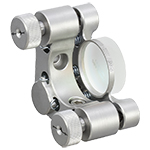
Click to Enlarge
POLARIS-K1C4 Mount with Optic and Optional POLARIS-N5 Removable Knobs
| Compatible Mounts |
|---|
| POLARIS-K25S4/M POLARIS-K25F4/M POLARIS-K1C4 POLARIS-K1G4 POLARIS-K1S4 POLARIS-K1S5 POLARIS-K15S4 POLARIS-K15F4 POLARIS-K50S4/M POLARIS-K50F4/M POLARIS-K2VS2 POLARIS-K2VS2L |
- For Convenient Adjustment of 1/4"-100 Adjusters
- Attaches Directly to Adjuster Threading
- Sold Individually
The Polaris® Removable Knobs for 1/4"-100 Adjusters allows the user to adjust a Polaris kinematic mirror mount by hand. The knobs can be used with select Polaris mounts, listed in the table to the right. Note that when the knobs are used with any of these mounts, they will block the side through holes on the adjuster. The adjuster screw's 5/64" (2 mm) hex socket is still usable when the knobs are attached.
The knobs are made from chemically cleaned and heat-treated 303 stainless steel that provides vacuum compatibility down to 10-9 Torr at 25 °C with proper bake out (10-5 Torr at 25 °C without bake out).


Click to Enlarge
F25USK2 Knob Shown Attached to a POLARIS-K1E Mirror Mount
- Ø0.925" Knob for Additional Angular Resolution
- Clearance Hole Allows Access to Hex Socket of the Adjuster
This removable adjustment knob is compatible with many of our 1/4"-100 adjusters, including those used in the Ø1", Ø1.5", and Ø2" Polaris Kinematic Mounts and our Polaris Kinematic Platform Mount. The larger Ø0.925" size provides additional angular resolution over the standard Polaris knobs.
Please note that the F25USK2 knob is not compatible with Polaris mounts that use side-hole adjusters. The recessed bore of knob is not deep enough to allow the knob to engage the threads on the side-hole adjuster.

- For Convenient Adjustment of 5/64" and 2 mm Hex-Driven Actuators
- Red Anodized Adjustment Knob with Engraved Hex Size
- Replaceable Hex Tip
- Sold in Packages of 4
These 5/64" Hex Key Adjuster Thumbscrews allow for quick adjustment of many 5/64" and 2 mm hex-driven actuators (or standard actuators with the knobs removed). These temporary knobs can be left in the screw's hex socket between adjustments for convenience (see photo to the right). An 8-32 setscrew (5/64" hex) secures the replaceable hex bit, which can be reversed if the tip is stripped. Contact Tech Support to order replacement hex key bits.
We offer hex key thumbscrews in sizes from 0.050" to 3/16" and 2 mm to 5 mm.
 Products Home
Products Home


















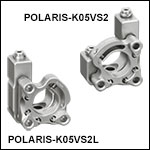
 Zoom
Zoom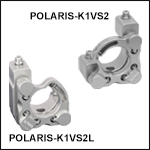

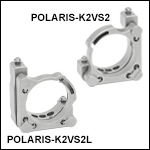
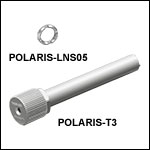
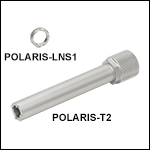
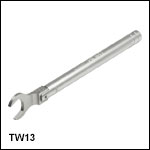




 Vertical-Drive Adjuster Polaris Mirror Mounts
Vertical-Drive Adjuster Polaris Mirror Mounts